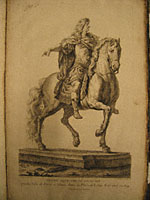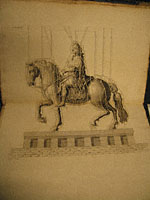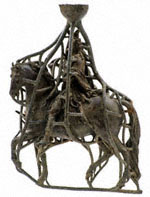The casting of a monumental equestrian bronze was considered the foundryman’s ultimate challenge. Because a successful monument required a balance of artistry, craftsmanship, and engineering, methods for successfully casting a monumental horse together with its rider have been studied and attempted for centuries, often ending in failure. The casting of the 30-foot-high statue of Louis XIV in Paris was a triumphant success. Cast in a single pour of metal in 1692 by Balthasar Keller from a model by François Girardon, the monument was made on-site in a foundry meticulously designed and built for the project. |
 |

 Engraving showing the equestrian monument to Louis XIV, in Place Louis-le-Grand (present-day Place Vendôme) in Paris |
The architect and draftsman Germain Boffrand recorded every detail of the casting of the monumental sculpture. He recounted each step, from the construction of the workshop and the wax casting model to the melting of the alloy and the final chasing of the bronze. His publication (image at right) includes engravings after his sketches, made “in order to record for posterity all the operations.”
Using the lost-wax casting technique, the multistep process included the creation of a full-size model, then the reproduction of that model in wax. This hollow “casting model” was then embedded—inside and out—in a heavily reinforced, fire-resistant mold constructed on an iron grid deep within the casting pit. The mold was then baked until all the wax burned away, leaving space to be filled with molten bronze. The bronze was heated in a furnace constructed above the mold. Once melted, the liquid metal flowed into the mold assisted by gravity. When cool, the mold was removed and the tremendously time-consuming step of cleaning and repairing the bronze was undertaken. The final stages included the application of a protective, varnishlike coating and the raising of the sculpture onto its monumental plinth.
|
 |

 Engraving showing the equestrian monument to Louis XIV, in Place Louis-le-Grand (present-day Place Vendôme) in Paris |
The image at right depicts a remarkable and rare bronze that retains the sprues (channels) that, during casting, allowed molten bronze into the mold and let gases escape. The bronze has been left nearly untouched since it was removed from its mold, and it illustrates the nearly flawless cast that can be achieved through the skillful alignment of sprues. |
 |

 Louis XIV on Horseback Louis XIV on Horseback, cast by Roger Schabol after a model by Martin Desjardins, early 1700s |